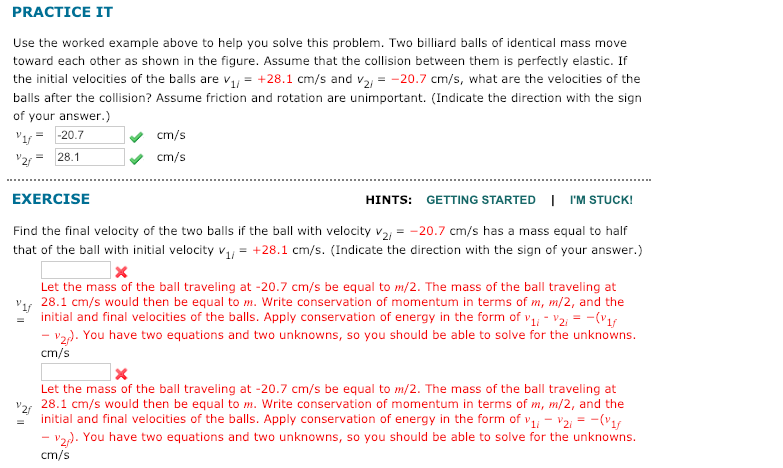PRACTICE IT Use the worked example above to help you solve this problem. Two billiard balls of identical mass move toward each other as shown in the figure. Assume that the collision between them is perfectly elastic. If the initial velocities of the balls are v = +28.1 cm/s and v2 = -20.7 cm/s, what are the velocities of the balls after the collision? Assume friction and rotation are unimportant. (Indicate the direction with the sign of your answer.) -20.7 cm/s 28.1 cm/s EXERCISE HINTS: GETTING STARTED I I'M STUCK! Find the final velocity of the two balls if the ball with velocity v2, = -20.7 cm/s has a mass equal to half that of the ball with initial velocity v1/ = +28.1 cm/s. (Indicate the direction with the sign of your answer.) Let the mass of the ball traveling at -20.7 cm/s be equal to m/2. The mass of the ball traveling at vs 28.1 cm/s would then be equal to m. Write conservation of momentum in terms of m, m/2, and the initial and final velocities of the balls. Apply conservation of energy in the form of v1; - v2 = -(V1 - v2). You have two equations and two unknowns, so you should be able to solve for the unknowns. cm/s Let the mass of the ball traveling at -20.7 cm/s be equal to m/2. The mass of the ball traveling at V2, 28.1 cm/s would then be equal to m. Write conservation of momentum in terms of m, m/2, and the initial and final velocities of the balls. Apply conservation of energy in the form of v1, - V21 = -(V1 - v2). You have two equations and two unknowns, so you should be able to solve for the unknowns. cm/s
PRACTICE IT Use the worked example above to help you solve this problem. Two billiard balls of identical mass move toward each other as shown in the figure. Assume that the collision between them is perfectly elastic. If the initial velocities of the balls are v = +28.1 cm/s and v2 = -20.7 cm/s, what are the velocities of the balls after the collision? Assume friction and rotation are unimportant. (Indicate the direction with the sign of your answer.) -20.7 cm/s 28.1 cm/s EXERCISE HINTS: GETTING STARTED I I'M STUCK! Find the final velocity of the two balls if the ball with velocity v2, = -20.7 cm/s has a mass equal to half that of the ball with initial velocity v1/ = +28.1 cm/s. (Indicate the direction with the sign of your answer.) Let the mass of the ball traveling at -20.7 cm/s be equal to m/2. The mass of the ball traveling at vs 28.1 cm/s would then be equal to m. Write conservation of momentum in terms of m, m/2, and the initial and final velocities of the balls. Apply conservation of energy in the form of v1; - v2 = -(V1 - v2). You have two equations and two unknowns, so you should be able to solve for the unknowns. cm/s Let the mass of the ball traveling at -20.7 cm/s be equal to m/2. The mass of the ball traveling at V2, 28.1 cm/s would then be equal to m. Write conservation of momentum in terms of m, m/2, and the initial and final velocities of the balls. Apply conservation of energy in the form of v1, - V21 = -(V1 - v2). You have two equations and two unknowns, so you should be able to solve for the unknowns. cm/s
Physics for Scientists and Engineers: Foundations and Connections
1st Edition
ISBN:9781133939146
Author:Katz, Debora M.
Publisher:Katz, Debora M.
Chapter11: Collisions
Section11.3: Conservation During A Collision
Problem 11.4CE
Related questions
Question

Transcribed Image Text:PRACTICE IT
Use the worked example above to help you solve this problem. Two billiard balls of identical mass move
toward each other as shown in the figure. Assume that the collision between them is perfectly elastic. If
the initial velocities of the balls are v = +28.1 cm/s and v2 = -20.7 cm/s, what are the velocities of the
balls after the collision? Assume friction and rotation are unimportant. (Indicate the direction with the sign
of
your answer.)
-20.7
cm/s
28.1
cm/s
EXERCISE
HINTS: GETTING STARTED I I'M STUCK!
Find the final velocity of the two balls if the ball with velocity v2, = -20.7 cm/s has a mass equal to half
that of the ball with initial velocity v1/ = +28.1 cm/s. (Indicate the direction with the sign of your answer.)
Let the mass of the ball traveling at -20.7 cm/s be equal to m/2. The mass of the ball traveling at
vs 28.1 cm/s would then be equal to m. Write conservation of momentum in terms of m, m/2, and the
initial and final velocities of the balls. Apply conservation of energy in the form of v1; - v2 = -(V1
- v2). You have two equations and two unknowns, so you should be able to solve for the unknowns.
cm/s
Let the mass of the ball traveling at -20.7 cm/s be equal to m/2. The mass of the ball traveling at
V2, 28.1 cm/s would then be equal to m. Write conservation of momentum in terms of m, m/2, and the
initial and final velocities of the balls. Apply conservation of energy in the form of v1, - V21 = -(V1
- v2). You have two equations and two unknowns, so you should be able to solve for the unknowns.
cm/s
Expert Solution
This question has been solved!
Explore an expertly crafted, step-by-step solution for a thorough understanding of key concepts.
This is a popular solution!
Trending now
This is a popular solution!
Step by step
Solved in 4 steps with 4 images

Recommended textbooks for you

Physics for Scientists and Engineers: Foundations…
Physics
ISBN:
9781133939146
Author:
Katz, Debora M.
Publisher:
Cengage Learning

Physics for Scientists and Engineers: Foundations…
Physics
ISBN:
9781133939146
Author:
Katz, Debora M.
Publisher:
Cengage Learning